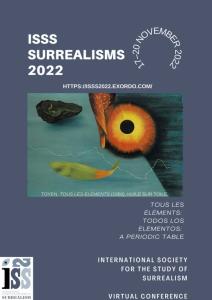Vera Bornkessel - Le tamanoir d’André Breton. Les représentations animales dans le surréalisme 1924-1969
Conférence
Vera Bornkessel - Le tamanoir d’André Breton. Les représentations animales dans le surréalisme 1924-1969
Conférence dans le cadre de ISSS Surrealisms 2022, Tous les éléments: Todos los elementos: A Periodic Table, Virtual Conference Event
“The flora and fauna of Surrealism are inadmissible,” writes André Breton in his Manifesto in 1924 [1]. Indeed, numerous animals and creatures inhabit the fantastic cosmos of the surrealist movement and hold a central position in its conception of the world. The contexts in which the animal appears vary, as do the functions it occupies.
Which aspects of the animal are presented by the surrealists? Which functions do animals serve in the works of these artists?
The Surrealists' intensive examination of the animal is based on their world view, which takes a critical stance towards the categorizing principle of the exact sciences, such as developed in Carl von Linné's zoological classification system. Against the background of Charles Darwin’s theory of evolution and Sigmund Freud’s psychoanalysis, new questions arose about the relationship between human and animal. The Surrealist group reacted by delving into an unexplored fable world of the animal that is unfathomable to man.
In my presentation, I will focus on one chapter of my PhD thesis examining the anteater as one remarkable animal in Surrealism. The scurrilous creature gained a particular significance from the very beginning of the surrealist movement, as Breton pointed out in 1949: “The surrealist bestiary gives pride of place, above all other species, to animals that are sui generis and have an aberrant or decadent appearance such as the platypus, the praying mantis, or the anteater” [2]. It’s particular role for the movement is shown by various representations in surrealist works, from André Breton's Ex libris in 1930 and his sculpture Le grand tamanoir in 1962 to Dali's performance with a living anteater in the Paris metro station in 1969 or Leonora Carrington's illustrations for the pamphlet The anteater’s Umbrella in 1971.
Considering the Surrealist approach to (or artistic treatment of) the beast, it can be grasped with the concept of the "diagonal sciences", an axiom developed by Roger Caillois, member of the Surrealist group from 1932 to 1935, writer, sociologist and literary critic. With Caillois, we can understand the animal as a prism that represents phenomena of science and life in a pictorial way.
What does the anteater as a peculiar beast tell us about Surrealism's rapport to the animal?
[1] André Breton, Manifestoes of Surrealism [“Manifeste du surréalisme”, 1924], trans. Richard Sever and Helen R. Lane, Ann Arbor: University of Michigan Press 1969, p. 40.
[2] André Breton, “Caught in the Act” [“Flagrant délit”, 1949], in: Free Rein (La Clé des champs), trans. Michel Parmentier and Jacqueline d’Amboise, Lincoln, NE and London: University of Nebraska Press 1996, p. 129.
Location: ISSS Surrealisms 2022, 17 - 20 Nov 2022, International Society for the Study of Surrealism, Virtual Conference Event (Link zur Online-Konferenz : https://event.isss2022.exordo.com/)
Link zur Online-Konferenz: https://event.isss2022.exordo.com/presentation/87/le-tamanoir-dandre-breton-les-representations-animales-dans-le-surrealisme-1924-1969
Collègue(s) du DFK Paris impliqué·e(s)





